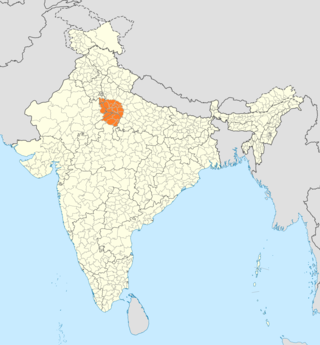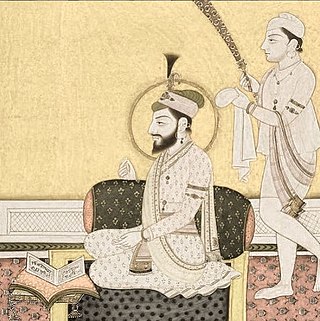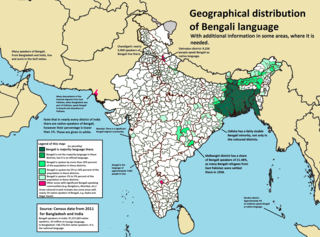
Punjabi, sometimes spelled Panjabi, is an Indo-Aryan language native to the Punjab region of Pakistan and India. It is one of the most widely spoken native languages in the world with approximately 113 million native speakers.

Urdu is an Indo-Aryan language spoken chiefly in South Asia. It is the national language and lingua franca of Pakistan, where it is also an official language alongside English. In India, Urdu is an Eighth Schedule language whose status and cultural heritage is recognised by the Constitution of India; and the Deoband school played a key role in establishing Urdu as the language of Indian Muslims, and it also has an official status in several Indian states. In Nepal, Urdu is a registered regional dialect and in South Africa it is a protected language in the constitution. It is also spoken as a minority language in Afghanistan and Bangladesh, with no official status.

Hindustani is an Indo-Aryan language spoken in Deccan, Northern India and Pakistan, and used as a lingua franca in both countries. Hindustani is a pluricentric language with two standard registers, known as Hindi and Urdu. Thus, it is also called Hindi–Urdu. Colloquial registers of the language fall on a spectrum between these standards. In modern times, a third variety of Hindustani with significant English influences has also appeared which is sometimes called Hinglish.

The Indo-Aryan languages are a branch of the Indo-Iranian languages in the Indo-European language family. As of the early 21st century, they have more than 800 million speakers, primarily concentrated in India, Pakistan, Sri Lanka, Bangladesh, Nepal and Maldives. Moreover, apart from the Indian subcontinent, large immigrant and expatriate Indo-Aryan–speaking communities live in Northwestern Europe, Western Asia, North America, the Caribbean, Southeast Africa, Polynesia and Australia, along with several million speakers of Romani languages primarily concentrated in Southeastern Europe. There are over 200 known Indo-Aryan languages.

Gujarati is an Indo-Aryan language native to the Indian state of Gujarat and spoken predominantly by the Gujarati people. Gujarati is descended from Old Gujarati. In India, it is one of the 22 scheduled languages of the Union. It is also the official language in the state of Gujarat, as well as an official language in the union territory of Dadra and Nagar Haveli and Daman and Diu. As of 2011, Gujarati is the 6th most widely spoken language in India by number of native speakers, spoken by 55.5 million speakers which amounts to about 4.5% of the total Indian population. It is the 26th most widely spoken language in the world by number of native speakers as of 2007.
Indian English (IE) is a group of English dialects spoken in the Republic of India and among the Indian diaspora. English is used by the Indian government for communication, along with Modern Standard Hindi, as enshrined in the Constitution of India. English is also an official language in seven states and seven union territories of India, and the additional official language in seven other states and one union territory. Furthermore, English is the sole official language of the Indian Judiciary, unless the state governor or legislature mandates the use of a regional language, or if the President of India has given approval for the use of regional languages in courts.

Languages spoken in the Republic of India belong to several language families, the major ones being the Indo-Aryan languages spoken by 78.05% of Indians and the Dravidian languages spoken by 19.64% of Indians; both families together are sometimes known as Indic languages. Languages spoken by the remaining 2.31% of the population belong to the Austroasiatic, Sino–Tibetan, Tai–Kadai, and a few other minor language families and isolates. According to the People's Linguistic Survey of India, India has the second highest number of languages (780), after Papua New Guinea (840). Ethnologue lists a lower number of 456.

Pakistan is a multilingual country with over 70 languages spoken as first languages. The majority of Pakistan's languages belong to the Indo-Iranian group of the Indo-European language family.

Magahi, also known as Magadhi, is a Indo-Aryan language spoken in Bihar, Jharkhand and West Bengal states of eastern India, and in the Terai of Nepal. Magadhi Prakrit was the ancestor of Magahi, from which the latter's name derives.

The Braj language, Braj Bhasha, also known as Vraj Bhasha or Brij Bhasha or Braj Boli, is a Western Hindi language. Along with Awadhi, it was one of the two predominant literary languages of North-Central India before the switch to Hindustani in the 19th century.

Shina is an Indo-Aryan language spoken by the Shina people. In Pakistan, Shina is the major language in Gilgit-Baltistan spoken by an estimated 1,146,000 people living mainly in Gilgit-Baltistan and Kohistan. A small community of Shina speakers is also found in India, in the Guraiz valley of Jammu and Kashmir and in Dras valley of Ladakh. Outliers of Shina language such as Brokskat are found in Ladakh, Kundal Shahi in Azad Kashmir, Palula and Sawi in Chitral, Ushojo in the Swat Valley and Kalkoti in Dir.

Sant Bhasha is a liturgical and scriptural language composed of vocabulary common to northern Indian languages, which was extensively used by saints and poets to compose religious verses. It can be understood by readers with a background in either Punjabi, Hindi-Urdu and its dialects.

The dialects of the Bengali language are part of the Eastern Indo-Aryan language group of the Indo-European language family widely spoken in the Bengal region of South Asia. The spoken dialects of Bengali are mutually intelligible with neighbouring dialects.

South Asia is home to several hundred languages, spanning the countries of Afghanistan, Bangladesh, Bhutan, India, Maldives, Nepal, Pakistan, and Sri Lanka. It is home to the third most spoken language in the world, Hindi–Urdu; and the sixth most spoken language, Bengali. The languages in the region mostly comprise Indo-Iranic and Dravidian languages, and further members of other language families like Austroasiatic, and Tibeto-Burman languages.

Bengali, generally known by its endonym Bangla, is an Indo-Aryan language native to the Bengal region of South Asia. With approximately 234 million native speakers and another 39 million as second language speakers as of 2017, Bengali is the sixth most spoken native language and the seventh most spoken language by the total number of speakers in the world. Bengali is the fifth most spoken Indo-European language.

Malwai is an Eastern Punjabi dialect of the Punjabi language, spoken in India and Pakistan. It originated in the Malwa region of Punjab.
The Punjabi dialects and languages, also known as Greater Punjabi, or simply Punjabi, are a series of dialects and language varieties spoken around the Punjab region of Pakistan and India, with varying degrees of official recognition. They have sometimes been referred to as the Greater Punjabi macrolanguage. Punjabi may also be considered as a pluricentric language with more than one standard variety.
Schwa deletion, or schwa syncope, is a phenomenon that sometimes occurs in Assamese, Hindi, Urdu, Bengali, Kashmiri, Punjabi, Gujarati, and several other Indian languages with schwas that are implicit in their written scripts. Languages like Marathi and Maithili with increased influence from other languages through coming into contact with them—also show a similar phenomenon. Some schwas are obligatorily deleted in pronunciation even if the script suggests otherwise.
Gambian English is the variety of English spoken in The Gambia. Gambian English has fewer speakers than any other variety of West African English (WAE), and shares similarities with Sierra Leonean English. The differences between Gambian English and other dialects of African English are mostly lexical and phonological. Gambian English has been influenced by various indigenous Gambian languages.
Sanskritisation is the process of introducing features from Sanskrit, such as vocabulary and grammar, into other languages. It is sometimes associated with the "Hindu-isation" of a linguistic community, or less commonly, with introducing a more upper-caste status into a community. Many languages throughout South Asia and Southeast Asia were greatly influenced by Sanskrit historically. Ancient Indian conceptualisations of Sanskrit grammar have also influenced modern linguistics.














